Small Systems Monthly Webinar Series
 Challenges and Treatment Solutions for Small Drinking Water Systems
Challenges and Treatment Solutions for Small Drinking Water Systems
Free webinars held each month from 2:00-3:00 pm ET (Optional Q&A session from 3:00-3:30 pm ET)
EPA's Office of Research and Development and Office of Water are hosting this monthly webinar series to communicate current small systems research along with Agency priorities. The series is providing a forum for EPA to communicate directly with state personnel and other drinking water small systems professionals, which allows EPA to provide training and foster collaboration and dissemination of information. This, in turn, provides state agencies with the information and resources they need to communicate the latest scientific advancements and current guidance to their small systems. The webinars are also providing EPA with invaluable information from the states on the problems that they are currently encountering in their day-to-day interactions with small systems. EPA researchers can then modify their research to solve real-world problems that small systems are experiencing.
Attendees have the option of receiving a certificate for one continuing education contact hour for each webinar. Acceptance of the certificates is contingent on state and/or organization requirements. EPA cannot guarantee acceptance.
Schedule and Registration (Subject to change)
- January 31, 2017 - Disinfectant Residuals
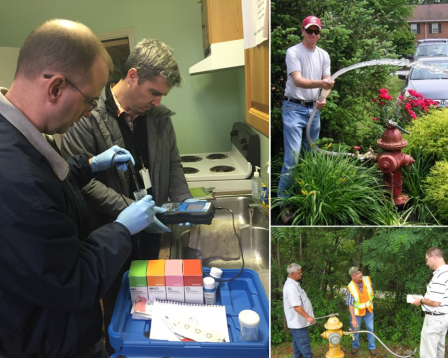
Presentation 1: Disinfectant Residual – Representative Monitoring and Minimum Residual Implications (Presented by Dr. Jonathan G. Pressman, EPA’s Office of Research and Development). For public drinking water systems in the U.S. using surface water and/or ground water under the influence of surface water sources, EPA and State regulations require residual disinfectants to be maintained throughout the water distribution system. However, minimum residual concentrations, number of samples, and locations for monitoring vary widely. This presentation will review the history of distribution system chlorine monitoring siting, overview the diversity in state regulations/guidance, and present a case study demonstrating an evaluation of chlorine monitoring locations in a distribution system. Finally, residual disinfectant concentration vs. coliform/E. coli data will be presented from the Agency’s recently released third Six-Year Review supporting the relationship between disinfectant residual and microbial stability reported in the scientific literature.
Presentation 2: Development of a Disinfectant Residual Monitoring Plan (Presented by Matthew Alexander, EPA's Office of Ground Water and Drinking Water). Maintaining adequate disinfectant residual throughout the distribution system is essential to assure public health protection. Collecting reliable chlorine residual data is necessary to ensure that disinfectant barrier is in place. This presentation will describe how to develop a monitoring plan that is representative of the overall distribution system, collect samples to accurately characterize water quality, and understand interferences and limitations of commonly used field methods.
About the Presenters
Jonathan G. Pressman, Ph.D., P.E. - Dr. Pressman is a Research Environmental Engineer in the Water Supply and Water Resources Division of U.S. EPA’s Office of Research and Development located in Cincinnati, Ohio. His research interests include characterizing natural organic matter in drinking water sources with particular emphasis on disinfection byproduct formation, membrane processes for both drinking water treatment and natural organic matter concentration, and disinfection and nitrification in drinking water distribution systems. Disinfection and nitrification research includes special interests in minimum residuals, molecular genetics and microbiological engineering. Dr. Pressman has a B.S. in civil engineering from Cornell University and a master’s and Ph.D. in civil engineering from The University of Texas at Austin. He is a registered professional engineer in Ohio and Texas.
Matthew Alexander - Matthew is an engineer in EPA’s Office of Groundwater and Drinking Water in Cincinnati, Ohio. As a member of the Agency’s Area-Wide Optimization Program (AWOP), he supports the development and demonstration of various optimization approaches and provides technical assistance related to distribution system water quality, with particular emphasis on maintaining disinfectant residual and storage tank operations. Matthew has a B.S. in civil engineering and a M.S. in environmental engineering from the University of Cincinnati. He is also a registered professional engineer in Ohio.
- February 28, 2017 - Source Water Protection
Registration and information coming soon.
- March 28, 2017 - Removal of Inorganic Contaminants of Interest: Strontium and Nitrates
Registration and information coming soon.
- April 25, 2017 - Water Security and Resiliency
Registration and information coming soon.
- May 30, 2017 - Water Systems Partnerships
Registration and information coming soon.
- June 27, 2017 - To be determined
Registration and information coming soon.
- July 25, 2017 - To be determined
Registration and information coming soon.
- August 29, 2017 - To be determined
Registration and information coming soon.
- September 26, 2017 - To be determined
Registration and information coming soon.
- October 31, 2017 - To be determined
Registration and information coming soon.
- November 28, 2017 - To be determined
Registration and information coming soon.
- December 12, 2017 - To be determined
Registration and information coming soon.
Past Webinars
Recordings and presentation slides are available below for past webinars, and are being hosted on the Association of State Drinking Water Administrators' (ASDWA) website. Exit (Note: Continuing education contact hour certificates cannot be offered for watching previously recorded webinars)
- Approaches to Technology Approval (December 13, 2016)
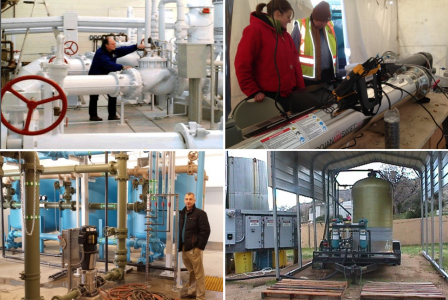
Webinar recording coming soon.
As part of the Science to Achieve Results grant program, EPA has funded two National Research Centers for Small Drinking Water Systems: The Design of Risk Reducing, Innovative Implementable Small System Knowledge (DeRISK) Center at the University of Colorado Boulder and the Water Innovation Network for Sustainable Small Systems (WINSSS) Center at the University of Massachusetts at Amherst. These centers will develop and demonstrate innovative technologies to better reduce, control and eliminate groups of chemical or microbial contaminants in small water systems. They are leveraging efforts with stakeholders and researchers involved in facilitating small drinking water system sustainability. The investment in the Center projects will enhance the resiliency of small systems and improve water quality, thereby, protecting public health. This webinar presented some of the centers’ drinking water treatment technology research efforts.
- Presentation 1 - Analysis of drinking water systems survey: Developing a better understanding of drinking water technology Approval (Presented by Steve Wilson, University of Illinois). The WINSSS Center presented the results of the survey, “Developing A Better Understanding of Drinking Water Technology Approval.” The Association of State Drinking Water Administrators and the DeRisk and WINSSS Centers conducted a survey of state primacy agencies to better understand the landscape surrounding regulatory acceptance and approval of new treatment technologies used by small community water systems. The survey focused on state barriers to acceptance, how emerging technologies are being used nationwide, how existing data sources are being used, what data are needed for acceptance, and states’ interest in working together for technology acceptance. This effort has led to the formation of a workgroup of state technology leads that are currently exploring possible approaches to developing a nationwide data sharing and evaluation approach to technology acceptance.
- Presentation 2 - Appropriate application of innovative technologies for small drinking water systems: The DeRISK Center’s decision support methodology (Presented by Dr. Bill Hogrewe, Rural Community Assistance Partnership). In addition to researching innovative drinking water technologies, the DeRISK Center is investigating strategies for assessment and implementation that can facilitate the selection and appropriate application of technologies that will optimize risk reduction and sustainability. This implementation approach is based on the development of a multi-criteria decision support methodology and a training design support tool. This methodology is designed to reconcile characteristics of drinking water technologies (innovative and conventional) with the preferences and technical, managerial, and financial capacity limitations of a given system. This presentation addressed the training design support tool and its goal to facilitate the creation of effective training packages and events on innovative technologies for stakeholders involved in the evaluation, approval, provision, and operation of these new and innovative technologies.
About the Presenters
Steve Wilson- Steve is a groundwater hydrologist who’s been with the Illinois State Water Survey at the University of Illinois since 1983. He authored “The Private Well Class,” an online self-paced curriculum for private well owners, and manages WaterOperator.org, an online resource for water and wastewater operators that supports small systems. He is past Director of the Midwest Technology Assistance Center, is involved in a number of small system initiatives with the Rural Community Assistance Partnership (RCAP), and is part of the WINSSS Center. Steve has a B. S. in Agricultural Engineering and a M. S. in Civil Engineering from the University of Illinois at Urbana-Champaign.
Bill Hogrewe, Ph.D., P.E.- Bill is the Director of Engineering Services at the Rural Community Assistance Partnership (RCAP). Prior to joining the RCAP National Office staff, he provided technical assistance and training for small community water and wastewater operators and managers with RCAC – the Western RCAP. He is an environmental engineer with over 40 years of experience in the planning, funding, design, construction, and operation of small and large water and wastewater facilities. He holds a B.S. in chemical engineering from Auburn University and M.S. and Ph.D. degrees in environmental engineering from the University of Colorado. He is a registered engineer in Colorado and Arizona.
- Capacity Development and Asset Management (November 29, 2016)
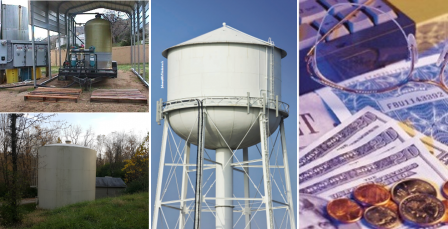
Webinar recording coming soon.
Capacity development program for public water systems (Presented by Adrienne Harris and Susanna Bains, EPA's Office of Water) The goal of the capacity development program is to strengthen technical, managerial, and financial capacities of public water systems to reliably provide safe drinking water. Asset management provides a framework that helps water systems make informed decisions about their water infrastructure management. Going through an asset management process will give systems a documented understanding of the assets they have, how long they will last, and how much it will cost to repair, rehabilitate or replace them. This presentation provided background on the Capacity Development program, discussed how asset management can be a tool for building the capacity of water systems, and provided EPA tools available to assist in the implementation of these programs.
Asset management for water and wastewater systems (Presented by Daniel J. Murray, Jr., P.E., BCEE – EPA's Office of Research and Development). There has been a profound transformation in the system management approach being taken by our water and wastewater utilities. Utilities are changing their focus from building and operating systems, to managing assets. This shift in perspective improves the ability of utilities to extend asset life; optimize maintenance and renewal; develop strategic, long-term funding plans; and sustain long-term performance. Asset management decision-making—throughout the life cycle of an asset—improves acquisition, operation, maintenance, and renewal. It also results in the lowest total cost of ownership. Effective asset management answers five core questions to reach its strategic goals:
- What is the current state of my assets?
- What is my required level of service?
- Which assets are critical to sustained performance?
- What are my best O&M and capital investment strategies?
- What is my best long-term funding strategy?
This presentation provided a high level overview of asset management, focusing on condition assessment, rehabilitation and renewal, risk-based and life-cycle decision-making, and total cost of ownership.
About the Presenters
Adrienne Harris- Adrienne joined EPA in 2005 as an environmental scientist where she has worked in the Office of Water's Office of Ground Water and Drinking Water. She has served as a member of the Effective Rule Implementation Team managing the Disinfectants and Disinfection Byproducts Rule, Consumer Confidence Report, and Public Notice rule. Adrienne has also worked with EPA’s Check Up Program for Small Systems and the Water You Waiting For workforce video. Prior to working in EPA HQ, Adrienne held similar duties with EPA Region 1. Adrienne holds a B.S. in Environmental Science from Spelman College and M.E.M. from Duke University. Adrienne currently serves as the Sustainable Systems Team Leader and the National Capacity Development coordinator.
Susanna Bains- Susanna joined EPA's Office of Ground Water and Drinking Water in January 2015. She is a Biologist for the Sustainable Systems Team at EPA Headquarters and coordinates Capacity Development and Asset Management initiatives. She received a B.S. in Biology from Samford University and an M.A. in Environmental Resource Policy from George Washington University.
Daniel J. Murray, Jr., P.E., BCEE - Dan is a Senior Environmental Engineer with EPA ORD in Cincinnati, Ohio. He is currently on a long-term assignment to the Metropolitan Sewer District of Greater Cincinnati, where he is leading their efforts to identify, evaluate, and adopt innovative technologies for the management and control of wet weather flows. Dan started his career with EPA in 1977, and then left in 1987 to work for the Massachusetts Water Resources Authority, where he led their Combined Sewer Overflow (CSO) control program. In 1990, he returned to EPA and joined ORD. In 2005, he led EPA’s Aging Water Infrastructure Research Program, a 5-year initiative based on the investigation and demonstration of emerging and innovative technologies for condition assessment and rehabilitation. Dan holds a MS in Civil/Environmental Engineering from Northeastern University in Boston, MA, and is a registered Professional Engineer in Massachusetts and Ohio, and a Board Certified Environmental Engineer. He received EPA’s Gold Medal for Exceptional Service for his work in supporting the development of the Agency’s CSO Policy.
- Legionella Control in Large Building Water Systems (October 25, 2016)
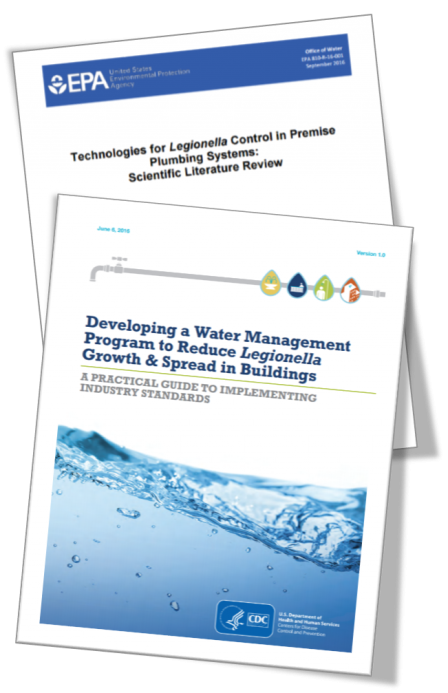
Technologies for Legionella control in premise plumbing systems (Presented by César Cordero, EPA’s Office of Ground Water and Drinking Water). EPA presented its recently released document, "Technologies for Legionella Control in Premise Plumbing Systems: Scientific Literature Review," which provides information on the use and effectiveness of Legionella control strategies in premise plumbing systems. This non-regulatory document provides technical information on Legionella control in premise plumbing in buildings. It can help states and facility owners/operators make better informed decisions on Legionella control (The document does not recommend any particular technology nor the installation of treatment, and it does not address concerns related to Legionella risk associated with cooling towers).
National toolkit for Legionella control in building water systems (Presented by Jessica Smith, Centers for Disease Control and Prevention). CDC presented its recently released toolkit, "Developing a Water Management Program to Reduce Legionella Growth and Spread in Buildings: A Practical Guide to Implementing Industry Standards." This toolkit is designed to help people understand which buildings and devices need a Legionella water management program to reduce the risk for Legionnaires’ disease, what makes a good program, and how to develop it. The toolkit aims to provide an easy-to-understand interpretation of ASHRAE Standard 188 to help building owners and managers evaluate the water system and devices in their building(s) to see if they need a program, and then develop an effective water management program if one is needed.
About the Presenters
César Cordero - César joined the Standards and Risk Reduction Branch (SRRB) of EPA’s OGWDW in 2007. During his time in SRRB, he has been involved in the review of the Revised Total Coliform Rule and the Long Term 2 Enhanced Surface Water Treatment Rule. He has also been involved in the development of the Contaminant Candidate Lists and has helped address issues related to emerging waterborne pathogens. César has a B.S. in Industrial Microbiology and an M.S. in Biology, both from the University of Puerto Rico-Mayaguez.
Jessica Smith - Jessica is an epidemiologist on the Legionella team, which sits in the Respiratory Diseases Branch within the National Center for Immunization and Respiratory Diseases at CDC. She received her Bachelor's degree in archaeology from Boston University and her Master of Public Health in epidemiology from San Diego State University. Prior to joining CDC, Jessica most recently served as an epidemiologist with the Dallas County Department of Health and Human Services in Dallas, Texas. In her role in Dallas, she was primarily responsible for Legionnaires' disease outbreak investigations at healthcare facilities, contact tracing and monitoring during the first domestic cluster of Ebola virus disease, and coordinating the assessment of persons under investigation for Ebola and MERS. Her current work at CDC focuses on coordinating outbreak response efforts and developing epidemiologic tools to support state and local health departments in Legionella outbreak investigations.
- Perfluorinated Chemicals: Analytics, Occurrence, and Treatment (September 27, 2016)

Three talks were given on perfluorinated chemicals (PFCs) with an emphasis on perfluorooctanoic acid (PFOA) and perfluorooctanesulfonic acid (PFOS). The first talk covered EPA’s analytical method for PFCs. This covered the approach, performance data, holding time studies, and contamination issues. The second talk covered source water issues for PFCs, including the impact of wastewater effluents. The third talk covered what is known from the literature regarding PFOA and PFOS treatment for the technologies commonly employed by drinking water facilities. For the technologies known to be effective, the applicability to drinking water treatment and a nation-wide cost evaluation was presented.
PFOS and PFOA: Analytics (Presented by Jody Shoemaker, EPA’s Office of Research and Development). EPA Method 537 was developed for the analysis of perfluoroalkyl acids (PFAAs) in drinking water to address the occurrence monitoring needs under EPA’s Unregulated Contaminant Monitoring Regulation (UCMR). The method employs solid-phase extraction with analysis by liquid chromatography/tandem mass spectrometry (LC/MS/MS). This presentation described the challenges associated with developing an analytical method for 14 PFAAs as well as demonstrate Method 537 performance data.
Evaluating occurrence and sources of PFAS to the environment (Presented by Marc Mills, EPA’s Office of Research and Development). Poly- and perfluorinated chemicals (PFAS) are used in many industrial and commercial applications. Understanding the occurrence of this class of chemicals is needed to better manage potential sources and to further characterize their fate and transport once released into the environment. Data from a number of monitoring studies and selected sources of PFAS was presented.
Removing PFOA and PFOS from Drinking Water (Presented by Thomas Speth, EPA’s Office of Water). PFCs such as PFOA and PFOS have unique physical-chemical characteristics that influence how they are removed by drinking water treatment technologies. This presentation covered what is known from the literature regarding PFOA and PFOS treatment for the technologies commonly employed by drinking water facilities. The number of these technologies that are known to be effective is limited. For the technologies known to be effective, the applicability to drinking water treatment and a nation-wide cost evaluation was presented. Finally, additional treatment data needs was discussed.
About the Presenters
Jody Shoemaker, Ph.D. - Jody is a Research Chemist at EPA, and is a principal investigator for projects involving the development of analytical methods for potential drinking water contaminants. She has been involved in the development of seven drinking water methods, including EPA Method 537 for perfluorinated alkyl acids, and two ambient water methods for cyanotoxins. These methods are used for compliance purposes or for use in unregulated contaminant monitoring. Jody has a B.S. in chemistry from Notre Dame College of Ohio and a Ph.D. from the University of Florida.
Marc A. Mills, Ph.D. - Marc is an Environmental Engineer at EPA, and is a principal investigator for projects characterizing the occurrence, transport, and fate of contaminants of emerging concern (CECs) and the management of contaminated sediments. He has been involved in the development of analytical methods for CECs for environmental samples in water, wastewater, solids, and tissues. These methods are used to characterize potential sources of CECs, their management in water, wastewater treatment, and new technology development. Marc has a B.S. in civil/environmental engineering from Texas A&M University and a M.S. and Ph.D. from the Texas A&M University.
Thomas Speth, Ph.D., P.E. - Tom is a Professional Engineer who has worked in the field of water treatment research at EPA for 30 years. He has a Ph.D. in environmental engineering from the University of Cincinnati, a master’s degree in civil/environmental engineering from Michigan Technological University, and a bachelor’s degree in chemical engineering from Michigan Technological University. Tom is a member of the AWWA, ASCE, ACS and IHSS. He has served as Trustee for AWWA's Water Quality & Technology Division, Associate Editor for ASCE's Journal of Environmental Engineering, and as a member of Journal AWWA’s Editorial Advisory Board. He is currently the Chair of AWWA’s Water Science and Research Division. Tom served as Branch Chief of EPA’s Treatment Technology Evaluation Branch from May 2005 to January 2009. From January 2009 to September 2015, he served as Division Director of EPA’s Water Supply and Water Resources Division. He is currently on a detail with the OGWDW as a Senior Engineering Advisor assigned to the Flint Enforcement Team under the 1431 Imminent and Substantial Endangerment Order.
- Removal of Multiple Contaminants: Biological Treatment and Ion Exchange (August 30, 2016)

Combined ion exchange for removal of dissolved organic carbon (DOC) and hardness (Presented by Treavor Boyer, Arizona State University). This presentation will provide an overview of combined anion exchange and cation exchange (hereafter combined ion exchange) as a single process to simultaneously remove DOC and hardness. The motivation for pursuing combined ion exchange is to remove multiple contaminants with a single treatment process that generates a single waste or residual stream. Combined ion exchange results will be presented from laboratory experiments and an ongoing pilot plant study. The combined ion exchange process will also be discussed in terms of reactor configuration (i.e., fixed bed or completely mixed), process operating conditions, regeneration efficiency and waste disposal, and appropriateness for small systems.
Capabilities of biological treatment for drinking water (Presented by Nicholas Dugan, EPA's Office of Research and Development). The biological treatment of drinking water is a process that has the potential to significantly reduce contaminant concentrations while minimizing the generation of treatment residuals. Contaminants of regulatory interest that have shown themselves amenable to removal through biological treatment include ammonia, nitrate, nitrite, and perchlorate. Biological treatment also has the capability to remove dissolved organic material that, though not directly regulated, is a precursor for the production of regulated disinfection byproducts (DBPs). This presentation will discuss the scientific fundamentals of biological treatment and present several case studies that serve to illustrate the capabilities of the process as well as operation and maintenance issues that need to be considered.
About the Presenters
Treavor Boyer, Ph.D. - Dr. Boyer is an Associate Professor at the School of Sustainable Engineering and the Built Environment, Arizona State University. where his research interest is water sustainability with many research projects on innovative applications of ion exchange technology. Dr. Boyer is the recipient of a National Science Foundation CAREER Award and his research has been sponsored by federal agencies including the Water Innovation Network for Sustainable Small Systems Center (WINSSS). WINSSS is one of two National Centers for Innovation in Small Drinking Water Systems that received EPA grants in 2013 to perform innovative research in small to medium sized drinking water systems. Dr. Boyer earned his Ph.D. and M.S. in environmental engineering from the University of North Carolina at Chapel Hill, and his B.S. in chemical engineering from the University of Florida.
Nicholas Dugan, P.E. - Nick is an engineer in Nick is an environmental engineer with EPA ORD's National Risk Management Research Laboratory in Cincinnati, Ohio, where he specializes in drinking water treatment. In addition to his work with cyanobacteria and cyanobacterial toxins, he has performed or supervised bench- and pilot-scale studies to evaluate the removal of nitrate, nitrite, ammonia, perchlorate, and disinfection byproduct precursors through biological drinking water treatment processes.
- Lead and Copper: Sampling and Water Quality Challenges (July 26, 2016)

Lead and copper tap sampling requirements and procedures (Presented by Edward Viveiros, EPA's Office of Water). This presentation provided a review of Lead and Copper Rule (LCR) tap water sampling requirements for small systems, including site selection and sample collection. It also provided clarification on recommended tap sampling procedures relating to aerators, pre-stagnation flushing and bottle configuration. The presentation will also point to instructional resources available to small systems.
Flint Michigan: water quality challenges and moving forward (Presented by Darren A. Lytle, EPA's Office of Research and Development). This discussion included a timeline of the key events in Flint, MI, as related to the elevated levels of lead in the drinking water. The different Flint drinking water sources involved were presented, along with changes in water quality parameters that were impacted by the different source waters. The crisis led to the establishment of the EPA Flint Technical Advisory Committee, and the task force recommendations was presented. In addition, sampling efforts that have taken place in Flint to-date were discussed, as well as planned pipe scale sampling associated with experimental pipe loop test rigs and excavated lead service lines. Other efforts underway include improving distribution system (DS) modeling and a DS flushing program. The results of a filter study were presented along with current corrosion control optimization efforts.
About the Presenters
Edward Viveiros - Edward is an environmental engineer at EPA's Office of Ground Water and Drinking Water, Drinking Water Protection Branch, where he serves as an implementation lead for the Lead and Copper Rule. Prior to that, he was an environmental consultant with Eastern Research Group. While there, he provided analytical support to EPA in the areas of wastewater management and chemical policy for seven years. He holds a Master's and a Bachelor's degree in chemical engineering from Northeastern University in Boston, MA.
Darren A. Lytle, Ph.D., P.E. - Dr. Lytle is an environmental engineer for the EPA's Office of Research and Development, National Risk Management Research Laboratory, Water Supply and Water Resources Division where he serves as the Acting Branch Chief for the Treatment Technology Evaluation Branch. Since beginning work at EPA in 1991, Dr. Lytle’s primary goal has been to research the quality of drinking water. Over the years, he has investigated and published works on drinking water systems, including work on distribution system corrosion control and water quality (e.g., red water control, lead and copper corrosion control); filtration (emphasis on removal of particles, and microbial contaminants and pathogens from water); biological water treatment; and iron and arsenic removal.
- Revised Total Coliform Rule (RTCR) for Small Systems (June 28, 2016)
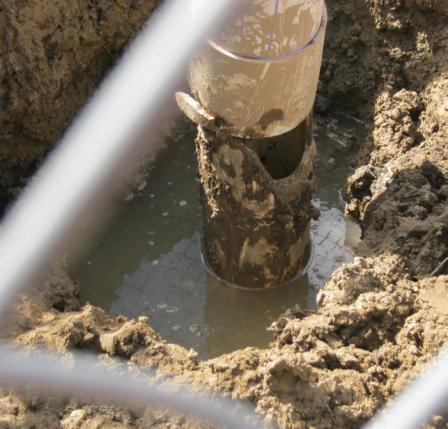
Recording coming soon.
Federal RTCR requirements applicable to small systems (Presented by Cindy Y. Mack, EPA’s Office of Water). This presentation discussed the federal RTCR requirements applicable to small systems serving less than or equal to 1,000 persons. Routine, additional routine, and repeat sampling requirements, and events that trigger a Level 1 or Level 2 assessment were addressed. The presentation also included the actions that public water systems (PWSs) should take once an assessment is triggered.
RTCR implementation from a state perspective: trials and triumphs (Presented by Mark J. Verbsky, Ohio EPA's Division of Drinking and Ground Waters, Southwest District Office.) . Implementation of the RTCR has presented most primacy agencies across the United States with a variety of challenges. Seasonal water system requirements, treatment technique triggers, Level 1 and Level 2 assessments, an E. coli maximum contaminant level (MCL) instead of a total coliform MCL, and a whole host of additional issues and protocols have been keeping primacy agencies very busy over the past three years. This presentation gave a brief glimpse into what Ohio EPA experienced and what has been developed in order to implement the RTCR in Ohio.
About the Presenters
Cindy Y. Mack - Cindy is an Environmental Protection Specialist and has worked in EPA’s Office of Ground Water and Drinking Water since 2002. She is currently the National Implementation Lead for the RTCR and Senior Project Manager of the Interstate Carrier Conveyance Program. Cindy has a B.S. in Public Health from the University of Massachusetts and a M.P.H. from Johns Hopkins University. She has over 20 years of experience working in both the private and public sectors in program/policy development and implementation. Specific policy areas have included PWS microbial rules; combined sewer/sanitary sewer overflows; and environmental justice, among others. In addition, Cindy was one of the principal rule writers of the Aircraft Drinking Water Rule..
Mark J. Verbsky, R.S. - Mark is entering his 28th year in the public health field, with over 22 years at the Ohio EPA as a PWS inspector. He is a Registered Sanitarian and a certified Class 3 water treatment plant operator in the state of Ohio. His primary focus has been on small PWSs, and he is an active member of multiple workgroups and the American Water Works Association. This is Mark’s second time revising the Total Coliform Rule for Ohio: first from 1996 to 2000 and again from 2013 to present
- Disinfection Byproducts (DBPs): Regulatory Issues and Solutions (June 14, 2016. Originally scheduled for April 26))

Recording coming soon.
Stage 2 disinfectant byproducts regulatory review and implementation challenges (Presented by Michael Finn, EPA's Office of Water). This presentation reviewed the Stage 2 Disinfectant and Disinfection Byproducts Rule (DBPR) monitoring and reporting requirements, Stage 2 monitoring plans and plan revisions, reduced and increased monitoring, consecutive system issues, and operational evaluations. It also reviewed the treatment technique requirements of the Stage 1 DBPR that PWSs must continue to satisfy.
Small System disinfection byproducts challenges and solutions in Washington State (Presented by Jolyn Leslie, Washington State Department of Health). Washington State has over 1,100 small community and non-transient non-community water systems that are required to comply with the DBP Rule and serve less than 3,300 population. Most of the DBP MCL exceedances in the State have been in these small systems. These systems include both surface water and groundwater sources. This presentation provided a summary of some of the water quality challenges facing these small systems and highlighted a few success stories.
About the Presenters
Michael Finn, P.E. - Michael is an Environmental Engineer with the Office of Groundwater and Drinking Water, Drinking Water Protection Branch. He joined EPA in 2001 to work on the development of the Long Term 2 Enhanced Surface Water Treatment Rule, the Stage 2 Disinfection Byproducts Rule and the Groundwater Rule and the related guidance documents. Michael is currently working with states and public water systems on the implementation of those rules, microbial water treatment issues, alternative treatment technologies and water availability and water efficiency in public water systems. Prior to coming to EPA, he was with the California drinking water program as a field engineer in the San Francisco Bay area. Michael holds a Bachelor of Science in Environmental Resources Engineering from Humboldt State University in Arcata, CA. He is a licensed professional engineer in California and Maryland and a certified water treatment operator.
Jolyn Leslie, P.E. - Jolyn is a regional engineer for the Washington State Department of Health Office of Drinking Water. She is a civil engineer with over 16 years of experience working with water systems. First as a Peace Corps volunteer in Honduras working on mainly small gravity fed water systems. For the last 14 years, she has been a regional engineer and is responsible for implementing the State’s Drinking Water Program in her assigned geographic region. She is also the regional DBP lead for the Northwest Regional Office. She is an active member of AWWA and volunteers both domestically and internationally for Water For People.
- Responding to Harmful Algal Blooms, Optimization Guidelines, and Sampling for Utilities (May 31, 2016)
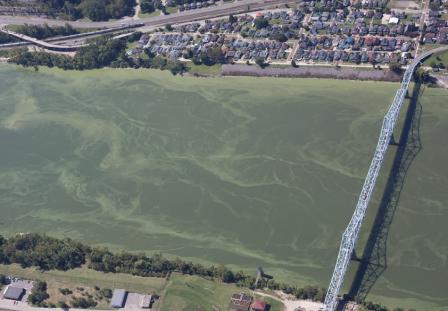
Removal capabilities of common treatment processes and facility evaluation strategies and performance improvement (Presented by Nicholas Dugan, EPA's Office of Research and Development). Harmful algal blooms (HABs), which include blooms of cyanobacteria, pose particular challenges and questions for small drinking water systems. Two of the most important are: “how well equipped is my facility to handle cyanobacterial cells and the toxins that may be released?” and “how can I improve my facility’s performance within rigid financial constraints?” This presentation reviewed the removal capacities of common processes used in drinking water treatment, presented a strategy for evaluating an existing treatment facility and discussed how to use this information to improve a facility’s performance.
Source and finished water monitoring options and their limitations and benefits (Presented by Heather Raymond, Ohio EPA) . There are a variety of tools that can be utilized to monitor a water system’s source and finished waters for HABs. Monitoring data can help a water system develop appropriate reservoir management strategies and optimize treatment for cyanotoxin removal. This presentation covered source and finished water monitoring options and their limitations and benefits. It also provided a few examples of how water systems in Ohio are using monitoring data to both focus reservoir management and optimize treatment following source and finished water cyanotoxin detections.
About the Presenters
Nicholas R. Dugan, P.E. - Nick is an environmental engineer with U.S. EPA’s Office of Research and Development/National Risk Management Research Laboratory in Cincinnati, Ohio, where he specializes in drinking water treatment. In addition to his work with cyanobacteria and cyanobacterial toxins, he has performed treatment studies to evaluate the control of cryptosporidium, nitrate, perchlorate, pesticides, and disinfection byproduct precursors.
Heather Raymond - Heather has almost 20 years of experience in Ohio EPA’s Division of Drinking and Ground Waters where she currently serves as the Harmful Algal Bloom Coordinator. She helped develop Ohio’s Harmful Algal Bloom Monitoring and Reporting Rules, the State of Ohio Recreation and Public Water System HAB Response Strategies, and HAB-related public water system guidance documents. She also co-teaches a practical workshop on HABs at Ohio State University's Stone Laboratory. She has helped water systems effectively respond to HABs in both their raw and finished drinking water.
- Point of Use/Point of Entry (POU/POE) Treatment Devices (March 29, 2016)
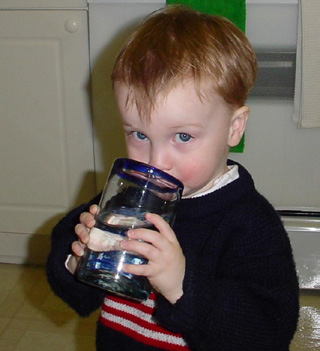
Household water systems: Tailoring treatment alternatives to contaminants in groundwater and distribution systems (Presented by Craig Patterson, EPA's Office of Research and Development). This presentation highlighted research case studies on household water treatment systems. EPA’s ORD has been evaluating the performance of POU/POE treatment systems designed for use in homes and small businesses for many years. Research studies will highlight the capabilities of kitchen sink membrane and carbon filters and their application to a wide variety of chemical and microbiological contaminants in well and tap waters. The research studies were conducted at EPA’s Test and Evaluation Facility and at field locations.
Point of use/point of entry case studies (Presented by Cynthia Klevens, New Hampshire Department of Environmental Services). About 1 in 5 bedrock wells in New Hampshire have unsafe levels of Arsenic, while others exceed the standards for Uranium, Radium and/or Gross Alpha contaminants. Approximately 90% of NH’s non-transient systems serve less than 1,000 people, and rely on private septic systems for wastewater disposal. This presentation included state regulatory requirements along with case studies where POU / POE treatment was approved as the best alternative to achieve water system compliance, due to the inability of community systems to discharge residuals onsite, or the cost-effectiveness of treating only the potable water needs for very small NTNC systems.
About the Presenters
Craig Patterson, P.E. - Craig is an environmental engineer with EPA's Office of Research and Development. He has over 35 years of experience with federal environmental programs and environmental consulting firms. Over the past 13 years, Craig’s research emphasis has been on drinking water treatment technologies for small communities of less than 500 people. His research has focused mainly on emerging and innovative water treatment technologies in support of EPA regulatory requirements including household water system studies. This effort has included collaborative field studies on a wide variety of surface and groundwater sources with researchers in EPA Regions, states, local health departments, water utilities, private industry, and academia.
Cynthia Klevens, P.E. - Cynthia is a chemical engineer with the New Hampshire Department of Environmental Services’ Drinking Water and Groundwater Bureau. She has 30 years’ experience in the environmental field, with half of that in drinking water treatment. Cynthia joined state government in 2005 to assist small public water systems and private wells with water treatment for arsenic, radionuclides and disinfection byproducts. Prior to that, she worked in the consulting industry. Cynthia also served as Technical Advisor for EPA’s Arsenic Demonstration Projects, and is a member of the NSF Joint Committee for Drinking Water Treatment Units.
- Consumer Confidence Reports: Electronic Delivery and Best Practices (February 23, 2016)

The Consumer Confidence Report (CCR) Rule is a National Primary Drinking Water Regulation that requires community water systems (CWSs) to create annual drinking water reports and distribute them to customers and consumer by July 1st each year. Among other requirements, the CCRs contain information about detected contaminants and if there were any health-based or monitoring violations in the past year. In 2012 EPA conducted a Retrospective review of the CCR Rule in which EPA interpreted the language in the regulation to allow electronic delivery of the CCR if certain requirements are met. CWSs serving 100,000 or more persons must also post their current year’s report to a publicly accessible site on the Internet. In this webinar we will review traditional and electronic delivery methods for the CCR as well as best practices for formatting the CCR. We will also highlight the CCR iWriter, a tool that walks a CWS through a series of questions and produces a CCR. Lastly we will highlight improvements to the CCR Where You Live Webpage where a CWS can link the URL to their CCR that is already posted online to the EPA website.
About the Presenters
Jamie Harris - Jamie has been in the field of hydrology for more than 20 years. Her experience is related to water quality, water supply and regulatory issues both related to the Clean Water Act and the Safe Drinking Water Act. Jamie has worked as an environmental consultant overseas as well as in Maryland. She has also worked for the Southern Nevada Water Authority and Maryland Environmental Service at Maryland Department of the Environment. At EPA Jamie oversees the implementation of a number of the National Primary Drinking Water Regulations including the CCR Rule, the Public Notification (PN) Rule, and the Chemical Phase Rules which includes over 65 Inorganic and Organic Contaminants.
Adrienne Harris - Adrienne joined EPA in 2005 as an environmental scientist. She has worked in EPA’s Office of Water since 2009. She has served as a member of the Effective Rule Implementation Team managing the Stage 1 Disinfectants and Disinfection Byproducts Rule (DBPR), Stage 2 DBPR, CCR Rule and PN Rule. Prior to working in EPA Headquarters, Adrienne held similar duties as an environmental scientist with EPA Region 1. Adrienne holds a B.S. in Environmental Science from Spelman College and a M.E.M. in Environmental Management from Duke University. Adrienne currently serves as the Sustainable Systems Team Leader.
- Uranium Standards in Drinking Water and Removal Technologies Research at Small Community Water Systems (February 2, 2016)

Uranium and health effects and uranium in drinking water standards. (Presented by Samuel Hernandez, EPA’s Office of Water). Community water systems must comply with the maximum contaminant levels established by the Radionuclides Rule for radium-226, radium-228, gross alpha particle activity, beta particle and photon radioactivity, and uranium. The Rule intends to reduce the consumer’s long term exposure to radiation in drinking water, thereby reducing the risk of cancer and improving public health protection. Uranium is a naturally occurring radioactive element and is present in virtually all soil, rock and ground water sources. Long-term exposure to uranium in drinking water in excess of EPA’s standard may result in kidney toxicity. This presentation will include an overview of uranium and health effects, followed by uranium in drinking water standards, including specifics about monitoring requirements, determining compliance, and violations.
Removal of uranium from drinking water by small system treatment technologies. (Presented by Thomas Sorg, EPA’s Office of Research and Development). Radionuclides, such as uranium, occur naturally as trace elements in rocks and soils; thus, they can be found in dissolved forms in ground waters, some of which are used as sources of drinking water. This presentation will include a short discussion of basic uranium chemistry followed by a discussion on small-system treatment technologies that are effective for uranium removal. These treatment technologies include coagulation/filtration, lime softening, anion exchange, activated alumina, and reverse osmosis. Both pilot- and full-scale treatment system information will be covered. The presentation will conclude with a discussion on residual disposal.
About the Presenters
Samuel Hernandez, P.E. - Sam is an environmental engineer with EPA’s Office of Ground Water and Drinking Water (OGWDW). He currently serves as the Drinking Water Radionuclides Rule manager, which includes responding to inquiries about the principles and applicability of the rule and providing support to states and to other EPA offices regarding the technical basis of the rule. Prior to joining EPA, Sam worked at the U.S. Nuclear Regulatory Commission as an environmental project manager where he coordinated the development and publication of environmental impact statements and safety evaluation reports related to the renewal of operating licenses of nuclear power plants. Sam has a B.S. in Chemical Engineering from the University of Puerto Rico and a M.S. in Environmental Engineering from the University of Maryland.
Thomas Sorg, PE, BCEE - Tom has over 51 years of experience with federal environmental programs. His experience includes the past 42 years with the drinking water research and development program of EPA, and 25 years as Chief of the Inorganics and Particulate Control Branch of the Drinking Water Research Division. Tom’s research emphasis has been on drinking water treatment technology for the removal of inorganic and radionuclide contaminants from water supplies, including the removal of arsenic. During the past 12 years, his research has focused mainly on treatment technologies to remove arsenic from drinking water in support of the revised arsenic MCL of 10 μg/L. This effort has included oversight of the EPA Arsenic Removal Full-Scale Demonstration Program.p>
